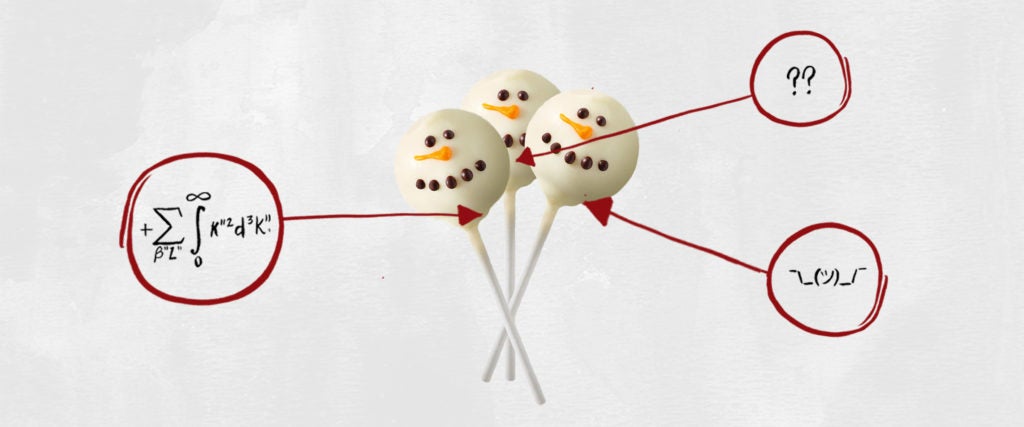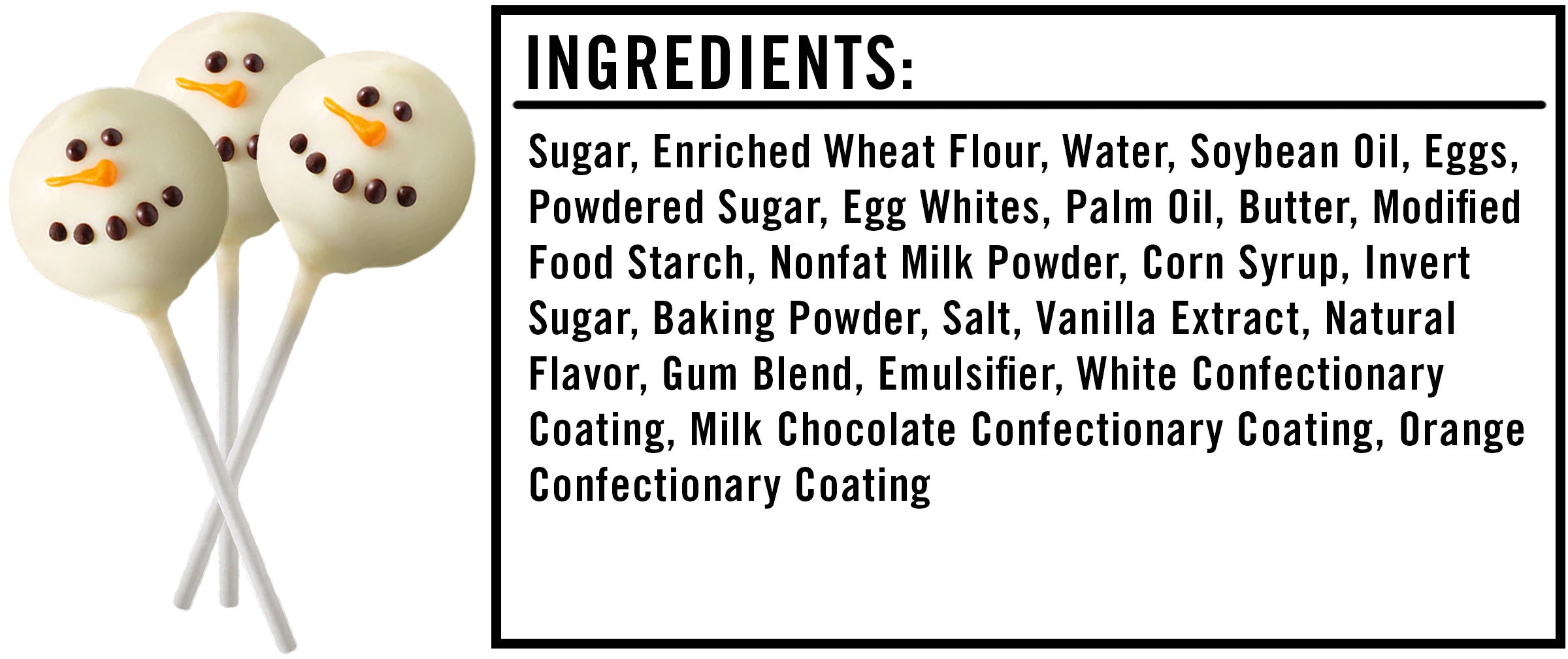We’re often told that you should never eat anything (or put anything on your body) if you don’t recognize everything on the ingredients list. But since most of us have no idea what xanthan gum or potassium benzoate are — or more importantly, what they’re doing to our bodies — we’re decoding the ingredients in the many things Americans put in (and on, or near) themselves.
This edition: Starbucks Snowman Cake Pops, which are made from more than 20 separate ingredients — many of which have their own ingredients lists — that we’ve broken down as they appear on the Starbucks website.
- Read Next: The Healthiest Breakfast at Starbucks
The Cake
1) Sugar: One Starbucks cake pop contains a whopping 18 grams of sugar — four more grams than a couple handfuls of gummy bears — which is quite a lot for something you can eat in a single bite. For reference, the American Heart Association recommends men consume no more than 36 grams and women consume no more than 25 grams of added sugar a day, meaning one cake pop can get you pretty damn close to your suggested daily limit.
2) Enriched Wheat Flour (Wheat Flour, Malted Barley Flour, Niacin, Reduced Iron, Thiamine Mononitrate, Riboflavin, Folic Acid): As we learned in our exploration of the many, many, many ingredients in the McDonald’s Big Mac, enriched flour can end up being far less “enriched” than the name would have you believe. In addition to containing more calories than whole wheat flour, the bleaching process enriched flour often undergoes produces an unfortunate byproduct: A chemical called alloxan, which has been found to induce diabetes in lab-animal test subjects by destroying their pancreas. Whether or not that applies to this enriched flour is hard to say.
3) Water: Together, water and flour make dough.
4) Soybean Oil: Using vegetable oil in baked goods increases how moist they are when taken out of the oven. While that makes them nicer to eat, according to physician and biochemist Cate Shanahan, consuming too much vegetable oil — which is easy to do, considering Shanahan says roughly 45 percent of the average American’s calories come from refined oils — has serious repercussions (e.g., fatty liver disease, insulin resistance and migraines).
5) Eggs: Eggs add structure, color and flavor to cakes by helping create a smoother, more voluminous batter.
6) Powdered Sugar (Sugar, Cornstarch): This is essentially just finely ground sugar, which results in a smoother end product than if granulated sugar were used. Cornstarch is added to prevent clumping.
7) Egg Whites (Egg Whites, Guar Gum, Triethyl Citrate): Egg whites add volume to cakes. Guar gum is derived from guar beans, and it acts as a stabilizer and thickener, contributing to the chewiness of these cake pops. Lastly, triethyl citrate, derived from citrus, is a whipping aid that creates a smoother foam.
8) Palm Oil: See soybean oil.
9) Butter (Pasteurized Cream, Natural Flavors): Butter causes steam and carbon dioxide to become trapped in the batter as it bakes, which motivates the cake pops to rise. What exactly these natural flavors are is unknown, but more generally, natural flavors are flavors derived from an actual food source — i.e., cherry flavoring taken from a real cherry.
10) Modified Food Starch: Modified food starch is extracted from the source — usually corn, potatoes or tapioca — then treated physically, enzymatically or chemically to partially break down the starch. It provides a moister mouthfeel without the chalkiness that some of these other ingredients can cause.
11) Nonfat Milk Powder (Nonfat Milk Solids, Whey Solids): Nonfat milk powder is another common baking ingredient, used primarily as shelf-stable milk. It lends a fluffier texture and richer flavor.
12) Corn Syrup: Corn syrup is a liquid sweetener made of glucose (aka sugar). It might as well be liquid sugar, unhealthiness and all.
13) Invert Sugar: Invert sugar is another liquid sweetener made from table sugar and water. It can be especially useful in baked goods because it retains moisture.
14) Baking Powder (Sodium Acid Pyrophosphate, Sodium Bicarbonate, Corn Starch, Monocalcium Phosphate): Sodium acid pyrophosphate and monocalcium phosphate react with baking soda (aka sodium bicarbonate) to produce carbon dioxide, which helps the dough rise. When consumed in moderation, monocalcium phosphate is nothing to worry about. However, an excessive amount of phosphates in the diet, particularly when contained in processed foods like Starbucks cake pops, can accelerate the aging process, increase the risk of heart disease and place undue stress on the kidneys.
15) Salt: To enhance the flavor.
16) Vanilla Extract (Water, Ethyl Alcohol, Sugar, Vanilla Bean Extract): Ethyl alcohol may seem like a standout ingredient in vanilla extract, but the FDA requires that all vanilla extracts have an ethyl alcohol content of at least 35 percent. This is because ethyl alcohol extracts flavors and fragrances from the vanilla bean and suspends them in a stable solution. Otherwise, it would be a different product.
17) Natural Flavor: See butter.
18) Gum Blend (Xanthan Gum, Guar Gum): Xanthan gum is a relatively harmless thickening agent. That said, those with bowel issues should be wary when consuming it, as a study found it to be a highly efficient laxative, just like that mocha frappuccino you ordered.
19) Emulsifier (Water, Sorbitan Monostearate, Polysorbate 60, Mono and Diglycerides and 2 or Less of Phosphoric Acid and Sodium Propionate): These are all emulsifiers (which help the ingredients in these cake pops blend together) and preservatives.
Going one at a time, sorbitan monostearate is a synthetic wax known to be safe. Polysorbate 60 is potentially less safe — according to several studies, it can cause organ toxicity and cancer in high doses. However, the FDA classifies it as safe for limited use in food.
As we learned in our exploration of all 39 ingredients in the Dodger Dog, mono and diglycerides are oftentimes packed with trans fats not listed on the nutrition facts label, which is incredibly problematic. Because trans fats are associated with an increased risk of heart disease, stroke and diabetes, consuming more than you think you are (because they were never listed on the label) could do serious damage to your body.
As for phosphoric acid, Shanahan previously said not to be concerned about the negative effects unless you have heartburn or acid reflux, in which case, the high acidity may induce inflammation. Finally, sodium propionate can irritate the skin in pure form but is believed to be safe in the small amounts commonly found in food.
20) Emulsifier (Mono and Diglycerides, Polysorbate 60, Citric Acid, BHT Antioxidant): Here are even more emulsifiers and preservatives. Citric acid naturally occurs in citrus fruits and is often added to foods to extend their shelf life.
Meanwhile, BHT, or butylated hydroxytoluene, is another common preservative added to prevent products from spoiling. Studies continue to go back and forth about whether or not it could be carcinogenic, making it hard to say whether the amounts in cake pops would cause you any harm.
21) Natural Flavor (Maltodextrin, Natural Flavor, Colored With Annatto and Turmeric): An artificial sugar made from maltose (aka malt sugar) and dextrose (a sugar derived from starches), maltodextrin is usually used as a thickener or filler ingredient to add bulk to processed food and to increase its shelf life. (Maltodextrin itself has a shelf life of two years.)
Annatto and turmeric, meanwhile, are natural sources of red and yellow coloring.
The Coating
1) White Confectionary Coating (Sugar, Palm Kernel and Palm Oils, Whey Powder, Nonfat Milk Powder, Soy Lecithin, Natural Flavor, Vanilla Flavor, Palm Oil (With Soy Lecithin)): All of these ingredients, most of which have been covered already, come together to form icing. Soy lecithin, making its first appearance on our list, a component of fat found in — you guessed it — soy. It works as yet another emulsifier.
2) Milk Chocolate Confectionary Coating (Sugar, Fractionated Palm Kernel Oil, Cocoa Powder (Processed With Alkali), Soy Lecithin, Nonfat Milk, Natural Flavor, Palm Oil (With Soy Lecithin)): “Fractionated” palm oil helps prevent the chocolate coating on protein and candy bars from melting. The problem with fractionation, a separation process, is that it can result in more trans fats.
Cocoa powder processed with alkali, meanwhile, is also known as Dutch process cocoa powder, which has a more earthy flavor than your average cocoa powder. “Consuming large amounts of alkalized cocoa powder is possibly unsafe due to the caffeine content,” Dagan Xavier, ingredient expert and co-founder of Label Insight, warned during our exploration of the ingredients in chocolate Muscle Milk. “This can cause problems for pregnant women, where the caffeine could cross the placenta and enter the bloodstream of the fetus.” Cocoa may also trigger migraines in those susceptible to them.
3) Orange Confectionary Coating (Sugar, Palm Kernel and Palm Oils, Whey Powder, Nonfat Milk Powder, Soy Lecithin, Natural Flavor, Vanilla Flavor, Palm Oil (With Soy Lecithin), Triglycerides, Maltodextrin, Annatto Extract (Color), Potassium Hydroxide): Triglycerides are partially human-made fats used in creating chocolate coatings. Those with liver disease or diabetes should avoid these, as they can put a lot of pressure on the liver.
And finally, potassium hydroxide is a stabilizer and thickener, often involved in chocolate processing to achieve a nice glaze.
The Takeaway
First of all, there are a lot of ingredients in these tiny-ass cake pops, which is more than a little unsettling. Some are fine, and some are concerning — mono and diglycerides, BHT, “fractionated” palm oil and polysorbate 60 all contribute to the overprocessing of these pops. And again, the sugar levels are off the charts.
Overall, cake pops are a bad, bad choice, but this is the price you pay when you choose to have cake for breakfast.


